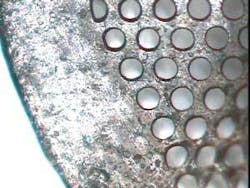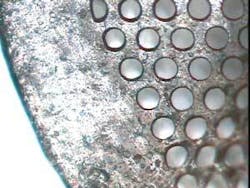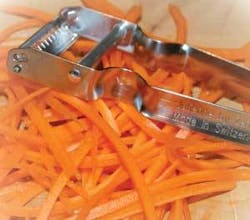A range of medical applications
Nashua, NH-In the treatment of cardiac disorders such as arrhythmia, catheters are directed to the heart via a femoral entrance. Then cauterization and cryogenic catheters selectively kill tissue. Excimer lasers strip polymer coating from the metal wires of cauterization devices to provide electrical access to these wires. Excimer laser thinning (outer-layer stripping) is used to increase the flexibility of devices to allow them to navigate tortuous arteries.
Originally, stents were tubes fabricated by laser as a metal mesh and inserted into a reopened vessel to support the vessel walls during the healing period. But in some cases, the body responds by coating the stent with scar tissue, a process called restenosis. One prevention has been to coat these stents with a polymer impregnated with an antirestenosis drug that is released over time, lowering restenosis rates. Polymer-coated metal stents can remain in the body permanently. However, it is speculated that the stent only needs to be in the body for three to six months as natural regeneration strengthens the vessel wall. Companies such as Resonetics (Nashua, NH; www.resonetics.com) are laser fabricating these next-generation stents (see cover).
When fully occluded vessels are being reopened, the very act of intervening and crossing the lesion may cause an embolic event. Devices such as balloon occluders use a balloon to temporarily stop blood flow. A vacuum suction tube removes debris created by a cutting balloon or other atherectomy device. With a partially occluded vessel, there is the potential for small emboli or plaque fragments to break free and pass through the partially occluded artery. In a worst-case scenario, these can reach the brain and cause a stroke. An embolic filter prevents the broken-off pieces from entering the vessels. This device is a small, parachute-like net that crosses the lesion area before in-stenting is performed, acting as a trap (see photo). The excimer-laser-drilled holes are large enough to allow blood flow, but small enough to catch any potentially dangerous debris.
Another area where excimer-based fabrication is playing a key role is in the treatment of multibranch lesions in bifurcated vessels-either Y- or T-shaped arteries. Here, the issue is treating multiple sites simultaneously and also dealing with vessels whose diameter varies within the region being treated. Using balloons of different diameter, introduced into the artery branches via side holes in the main catheter, that are deployed side by side addresses the branching. To shape the plastic devices to match the geometries of the arteries, the programmability of a laser-lathe technique enables the contour of the catheters and balloons to be shaped accordingly. In essence, the laser beam acts as a virtual lathe bit.
Excimer-laser micromachining, coupled with precision motion and machine vision systems, has proven to be a powerful tool for the microfabrication of intravascular devices.
Cadillac lights up
Rochester Hills, MI-North American Lighting, Inc (NAL-Illinois), with 23 years of experience in designing and manufacturing vehicle lights, called on by General Motors Cadillac for design changes to the 2007 Escalade rear tail lamp assemblies, turned to Urgent Plastics Services (UPS) for assistance in preparing the prototypes. UPS (www.urgentplastics.com), located here, has more than five years of experience working with automakers and suppliers to provide lighting components using rapid prototyping; in this case a laser-powered stereolithography (SLA) system.
After computer designs, created by NAL and modified by UPS, were approved they were relayed to the SLA equipment to produce a three-dimensional model in just a few hours. The SLA uses CAD data to generate a dimensional travel path for the laser beam that cures a photosensitive polymer, layer on layer, into the size and shape of the part. Once created the Escalade tail lamp lens and housing were used to create a negative urethane mold that was used to pour the first, single set of parts. CNC-machined plastic inserts simulated reflex optics on the finished part. These were mounted on a full-size clay model for design review. Final evaluations were approved and the go-ahead for aluminum injection molds for prototypes was given with UPS prototyping the lens pieces only. UPS supplied 50 sets of lens to NAL in just two weeks time.
After testing, a new optic feature was added, so the dies were redesigned and an additional 50 sets were made. Again, all in just two weeks time.
Production of the rear tail light assembly began on time so that the Escalade’s debut at this year’s Super Bowl held in Detroit was on schedule.-DAB
Laser welds a sharp blade
Affoltern, Switzerland-The patented Rex economy peeler was invented in the 1940s in Switzerland by Alfred Neweczerzal. Since then this device has been produced here by Zena AG with only a few modifications in model design. Today, more than 60 million have been sold.
This device is a 13mm wide U-shaped bent strip made of either aluminum or stainless steel with a pivoted super sharp blade and a side knife for cutting out the eyes of potatoes. Depending on the model, it consists of three to six components, which, even though largely handmade in Switzerland, is enormously cost-effective
Requests for cost-effective and well-functioning Julienne cutters became more frequent because the trend towards Asian cuisine made for higher interest in a practical device for slitting vegetables, in particular as the few devices already on the market were considered too blunt or too expensive premium products. At issue was how to join two chrome steel sheets with a thickness of only 0.2 to 0.7 mm with high precision and durability, if they are only a few millimeters wide and a few centimeters long. It was decided to refine the Rex vegetable peeler-to become a Julienne cutter.
The basic idea was to adapt the proven design by adding a second blade, which slits the already peeled vegetable into fine strips. The challenge turned out to be the efficient and high-strength joining of the steel blade with an additional blade that is made from a 0.3-mm chrome steel sheet, die-cut with 11 diagonal incisions. The lobes created are bent and form little triangular blades. This knife must be welded to the 0.8-mm blade with high precision.
Zena planned to produce approximately 300,000 Julienne cutters (see photo) during the first year in semi-automatic series production. In cooperation with Messer Schweisstechnik AG (Dällikon), they tested three joining techniques: resistance welding, micro- plasma welding, and laser welding.
In contrast to arc or plasma welding, the laser beam hits the welding spot accurately even in narrow geometries and does not walk off the edges. That facilitates the construction of a welding gauge, because for the most part the component can be used for the fixture and the weld spots need only be accessible from one side through small holes. The materials used, the joining geometry, and optimal cycle times during production are not a problem for laser welding. This was the reason laser welding was chosen despite the somewhat higher investment costs.
The StarWeld TT from Rofin meets the company’s requirement for a standard system that keeps investment costs reasonable despite the high value of complex laser technology. The system integrates the laser source, deflection unit, working chamber, and control unit in a compact housing.
While the laser is automatically welding a set of blades, a second magazine, holding 10 pairs of blades, can be unloaded and loaded manually. They are open for loading with the peeling blades put into the lower part and the Julienne knives into the upper part. Elastically supported magnetic pins keep them safely in place when the magazine is closed and then press them against the peeling blades during welding. The cycle time is determined by the user.
Rex will soon be available on the market as a Julienne cutter for only a slightly higher price. Orders for first lot sizes have already been placed.
With an investment budget of little more than 100,000 € for the complete laser solution, Zena was able to meet its financial schedule. Furthermore, the flexibility of the laser welding solution opens up additional new application perspectives-without extra costs.
For more information, visit www.rofin.com.



